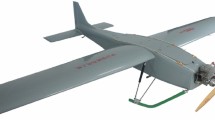Abstract
This paper considers the simultaneous attack problem of multiple missiles against a maneuvering target. Different from most of the existing literature in which the simultaneous attack problem is formulated as a consensus problem of missiles’ time-to-go estimates, this paper formulates it as the consensus problem of missiles’ ranges-to-go. Based on this strategy, novel distributed guidance laws are proposed to solve the simultaneous attack problem with the target of unknown maneuverability. Adaptive control method is introduced to estimate the upper bound of the target’s acceleration. The effectiveness of the proposed guidance laws is verified both theoretically and numerically.
Similar content being viewed by others
References
Jeon I, Lee J, and Tahk M, Impact-time-control guidance law for anti-ship missiles, IEEE Transactions on Control Systems Technology, 2006, 14(2): 260–266.
Wen G, Duan Z, YuW, et al., Consensus in multi-agent systems with communication constraints, International Journal of Robust and Nonlinear Control, 2012, 22(2): 170–182.
Liu Y, Zhao Y, and Chen G, Finite-time formation tracking control for multiple vehicles: A motion planning approach, International Journal of Robust and Nonlinear Control, 2016, 26(14): 3130–3149.
Li Z, Wen G, Duan Z, et al., Designing fully distributed consensus protocols for linear multi-agent systems with directed graphs, IEEE Transactions on Automatic Control, 2015, 60(4): 1152–1157.
Li Z, Chen M, and Ding Z, Distributed adaptive controllers for cooperative output regulation of heterogeneous agents over directed graphs, Automatica, 2016, 68: 179–183.
Zhao Y, Liu Y, Li Z, et al., Distributed average tracking for multiple signals generated by linear dynamical systems: An edge-based framework, Automatica, 2017, 75: 158–166.
Zhao Y, Liu Y, Wen G, et al., Distributed optimization of linear multi-agent systems: Edge-and node-based adaptive designs, IEEE Transactionson Automatic Control, 2017.
Yu W, Ren W, Zheng W X, et al., Distributed control gains design for consensus in multi-agent systems with second-order nonlinear dynamics, Automatica, 2013, 49(7): 2107–2115.
Antonelli G, Interconnected dynamic systems: An overview on distributed control, IEEE Control Systems Magazine, 2013, 33(1): 76–88.
Liu T and Jiang Z P, Distributed output-feedback control of nonlinear multi-agent systems, IEEE Transactions on Automatic Control, 2013, 58(11): 2912–2917.
Liu T and Jiang Z P, Distributed formation control of nonholonomic mobile robots without global position measurements, Automatica, 2013, 49(2): 592–600.
Liu T and Jiang Z P, Distributed nonlinear control of mobile autonomous multi-agents, Automatica, 2014, 50(4): 1075–1086.
Dong X, Xi J, Lu G, et al., Formation control for high-order linear time-invariant multi-agent systems with time delays, IEEE Transactions on Control of Network Systems, 2014, 1(3): 232–240.
Cheng L, Hou Z G, and Tan M, A mean square consensus protocol for linear multi-agent systems with communication noises and fixed topologies, IEEE Transactions on Automatic Control, 2014, 59(1): 261–267.
Dong X, Yu B, Shi Z, et al., Time-varying formation control for unmanned aerial vehicles: Theories and applications, IEEE Transactions on Control Systems Technology, 2015, 23(1): 340–348.
Jeon I and Lee J, Homing guidance law for cooperative attack of multiple missiles, Jounal of Guidance, Control, and Dynamics, 2010, 33(1): 275–280.
Zhang P, Liu H, Li X, and Yao Y, Fault tolerance of cooperative interception using multiple flight vehicles, Journal of the Franklin Institute, 2013, 350(9): 2373–2395.
Zhou J and Yang J, Distributed guidance law design for cooperative simultaneous attacks with multiple missiles, Journal of Guidance, Control, and Dynamics, 2016, 39(10): 2439–2447.
Slotine J and Li W, Applied Nonlinear Control, China Machine Press, Beijing, 2004.
Author information
Authors and Affiliations
Corresponding author
Additional information
This research was supported by the National Natural Science Foundation of China under Grant Nos. 61473005, 11332001, and 61471242, the Research Project Fund under Grant No. 17-163-11-ZT-003-018-01, the Air Force Advance Research Fund under Grant No. 303020503, the Joint Fund of Equipment development and Aerospace Science and Technology under Grant No. 6141B0624050101, and the National Defense Basic Scientific Research Program (Major) of China.
This paper was recommended for publication by Editor SUN Jian.
Rights and permissions
About this article
Cite this article
Zhou, J., Lü, Y., Li, Z. et al. Cooperative Guidance Law Design for Simultaneous Attack with Multiple Missiles Against a Maneuvering Target. J Syst Sci Complex 31, 287–301 (2018). https://doi.org/10.1007/s11424-018-6317-7
Received:
Revised:
Published:
Issue Date:
DOI: https://doi.org/10.1007/s11424-018-6317-7




